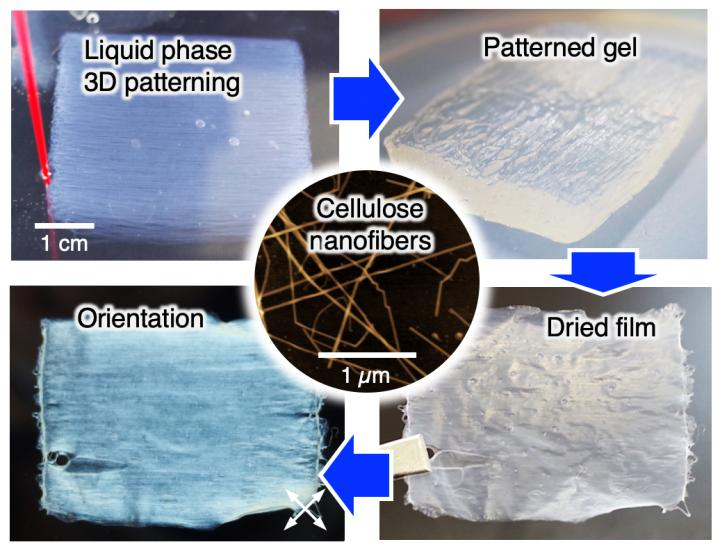May 20 2020
At The Institute of Scientific and Industrial Research of Osaka University, a team of researchers has devised a new liquid-phase fabrication method for synthesizing nanocellulose films with multiple axes of alignment.
 Development concept of nanocellulosic oriented film based on liquid-phase 3D patterning technology. Image Credit: Osaka University.
Development concept of nanocellulosic oriented film based on liquid-phase 3D patterning technology. Image Credit: Osaka University.
This study, which involves the use of 3D-printing methods for optimized control, could help develop inexpensive and more eco-friendly optical and thermal devices.
In the 1960s, the game of “three-dimensional chess” appeared for the first time on the original Star Trek TV show. Since then, it has been used as a metaphor for advanced thinking. At present, researchers from Osaka University can boast that they have developed their own version, with prospective applications in modern optics and low-cost smartphone displays.
Several existing optical devices such as liquid-crystal displays (LCDs) used in older flat-screen televisions are developed based on long needle-shaped molecules aligned in the same direction. But it is highly challenging to make fibers to line up in multiple directions on the same device.
A technique that can inexpensively and reliably synthesize optical fibers would expedite the production of low-cost displays or even “paper electronics”—computers that can be printed from biodegradable materials as per requirements.
Cellulose is the primary component of wood and cotton, and it is an abundant renewable resource composed of long molecules. Nanocelluloses are nanofibers formed of cellulose molecular chains that are uniaxially aligned, with different heat conduction and optical properties along one direction compared to another.
In a new study led by the Institute of Scientific and Industrial Research at Osaka University, researchers harvested nanocellulose from sea pineapples, a type of sea squirt. Then, liquid-phase 3D-patterning was used, combining the wet spinning of nanofibers with the precision of 3D-printing. A tailor-made triaxial robot was used for dispensing a nanocellulose aqueous suspension into an acetone coagulation bath.
We developed this liquid-phase three-dimensional patterning technique to allow for nanocellulose alignment along any preferred axis.
Kojiro Uetani, Study First Author, Institute of Scientific and Industrial Research, Osaka University
The researchers were able to program the direction of the patterns such that an alternating checkerboard pattern of horizontally- and vertically-aligned fibers was formed.
The team demonstrated the method by sandwiching a film between two orthogonal polarizing films. A birefringent checkerboard pattern was observed under the optimal viewing conditions. The optical retardation and thermal transfer properties were also quantified.
Our findings could aid in the development of next-generation optical materials and paper electronics. This could be the start of bottom-up techniques for building sophisticated and energy-efficient optical and thermal materials.
Masaya Nogi, Study Senior Author, Institute of Scientific and Industrial Research, Osaka University
Journal Reference:
Uetani, K., et al. (2020) Checkered Films of Multiaxis Oriented Nanocelluloses by Liquid-Phase Three-Dimensional Patterning. Nanomaterials. doi.org/10.3390/nano10050958.